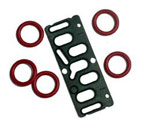
|
7108
S. Alton Way, Unit I |
(303) 758-2728
Comparison of General Use and High Performance Grades of Viton™

There are three major general use grades of Viton: A, B and F. They differ primarily in their resistance to fluids, and in particular aggressive lubricating oils and oxygenated fuels, such as methanol and ethanol automotive fuel blends. There is also a class of
General Use Grades:
Viton A: (vinylidene fluoride and hexafluoropropylene)
Viton A is a family of fluoroelastomer dipolymers, that is they are polymerized from two monomers, vinylidene fluoride (VF2) and hexafluoropropylene (HFP). Viton A fluoroelastomers are general purpose types that are suited for general molded goods such as o-rings and v-rings, gaskets, and other simple and complex shapes. There is a full range of Viton A grades that accomodate various manufacturing processes including transfer molding, extrusion, compression molding, and calendering.
Viton B: (vinylidene, hexafluoropropylene and tetrafluoroethylene)
Viton B is a grade of fluoroelastomer terpolymers, which means that they are polymerized from three monomers, vinylidene (VF2), hexafluoropropylene (HFP), and tetrafluoroethylene (TFE). Viton B fluoroelastomers offer better fluid resistance than A type fluoroelastomers. There is a full range of Viton B grades that accomodate a variety of manufacturing processes including compression molding, extrusion, and calendering.
Viton F:
Viton F is a grade of fluoroelastomer terpolymers, that is they are polymerized from three monomers, vinyl fluoride (VF2), hexafluoropropylene (HFP), and tetrafluoroethylene (TFE). Viton F fluoroelastomers offer the best fluid resistance of all Viton types. F types are particularly useful in applications requiring resistance to fuel permeation. There is a range of Viton F grades to accomodate various manufacturing requirements.
High Performance Grades:
Viton GB, GBL:
Viton GB and GBL are grades of fluoroelastomer terpolymers, that is they are polymerized from three monomers, vinyl fluoride (VF2), hexafluoropropylene (HFP), and tetrafluoroethylene (TFE). Viton GB and GBL use peroxide cure chemistry that result in superior resistance to steam, acid, and aggressive engine oils. There is full range of GB and GBL types that can accommodate most rubber processing requirements including compression, transfer molding, extrusion, and calendering.
Viton GLT:
Viton GLT is a fluoroelastomer designed to retain the high heat and the chemical resistance of general use grades of Viton, while improving the low temperature flexibility of the material. Glass transition temperatures (Tg) of materials are indicative of low temperature performance in typical elastomer applications. Viton GLT shows an 8 to 12°C lower Tg than general use Viton grades. There is a range of GLT products to accommodate various processing conditions.
Viton GFLT:
Viton GFLT is a fluoroelastomer designed to retain the high heat and the superior chemical resistance of the GF High Performance types, while improving the low temperature performance of the material. Viton GFLT shows a 6 to 10°C lower Tg than general use Viton grades. There is a range of GFLT products to accommodate various processing conditions.
Table Key: 1=Excellent, 2=Very Good, 3=Good, NR=Not Recommended
| Relative Chemical Compatibility and Mechanical Properties of Viton™ | |||||||
|---|---|---|---|---|---|---|---|
| General Use Grade Types | High-Performance Grade Types | ||||||
| Chemical Environment |
A | B | F | GB, GBL | GF | GLT | GFLT |
| Automotive and aviation fuels | 1 | 1 | 1 | 1 | 1 | 1 | 1 |
| Automotive fuels oxygenated with MEOH, ETOH, MTBE, etc. | NR | 2 | 1 | 2 | 1 | NR | 1 |
| Engine lubricating oil, SE and SF | 2 | 1 | 1 | 1 | 1 | 1 | 1 |
| Engine lubricating oil, SG and SH | 3 | 2 | 1 | 1 | 1 | 2 | 1 |
| Aliphatic hydrocarbon process fluids, chemicals | 1 | 1 | 1 | 1 | 1 | 1 | 1 |
| Aromatic hydrocarbon process fluids, chemicals | 2 | 2 | 1 | 1 | 1 | 2 | 1 |
| Aqueous fluids, steam, mineral acids | 3 | 2 | 2 | 1 | 1 | 1 | 1 |
| Compression and low-temperature performance |
|||||||
| Resistance to compression set | 1 | 2 | 2 | 2 | 3 | 2 | 2 |
| Low-temperature flexibility | 2 | 2 | 3 | 2 | 3 | 1 | 1 |
Next: Viton FKM Properties
* Photograph © Can Stock Photo Inc. | anekoho
We are located in the Denver Technological
Center in a suburb of Denver, Colorado
©1997-2017, Problem Solving Products, Inc.
Website Map | Privacy Statement
| Terms of Use



